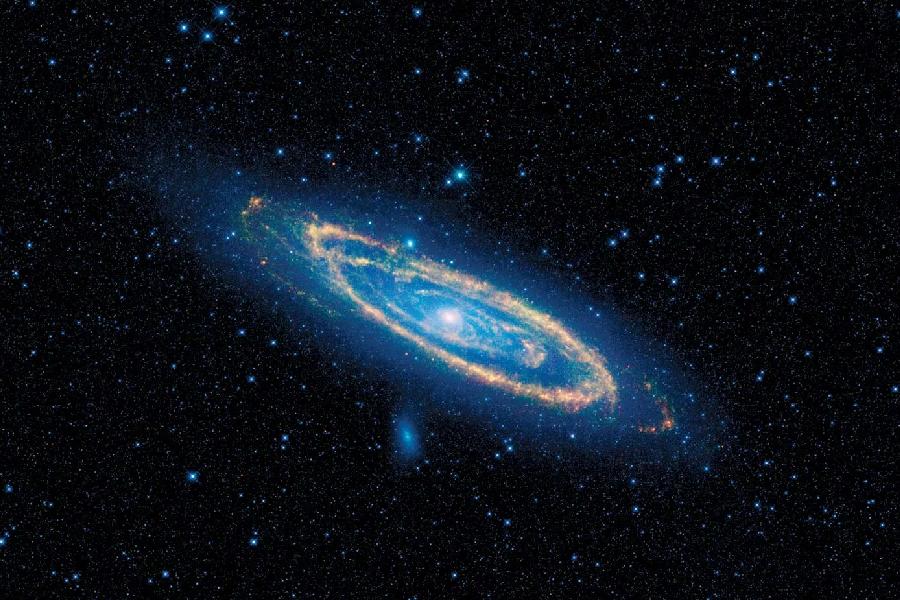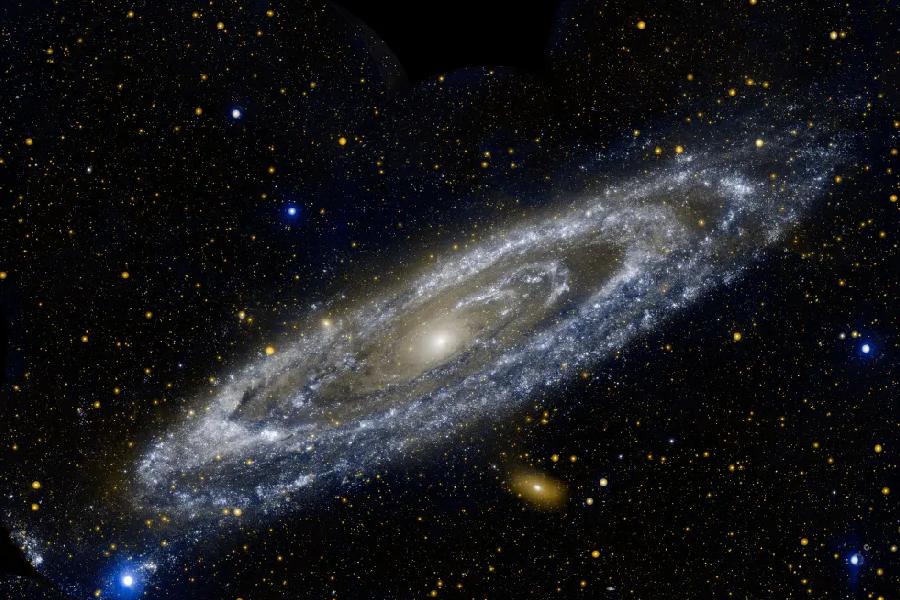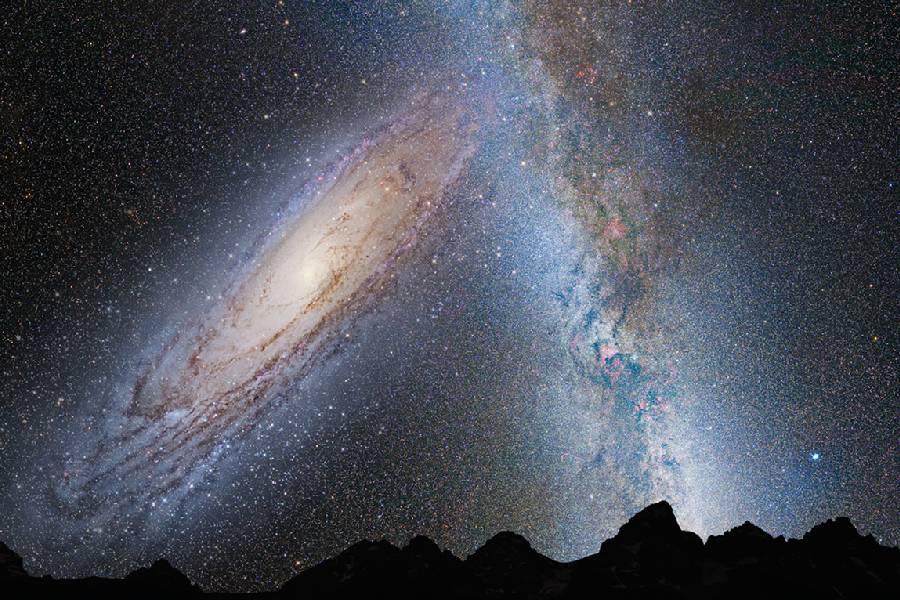The Andromeda Galaxy, our nearest large galactic neighbor, is a mysterious world of intrigue. At about 2.5 million light years from Earth, it appears as a faint, smudgy blob in our sky. But don’t let its unimpressive appearance fool you – Andromeda harbors over a trillion stars and countless uncharted worlds.
This article will take you on a journey to uncover Andromeda’s secrets. We’ll explore its structure as a large spiral galaxy similar to our Milky Way. We’ll gaze at the supermassive black hole at its heart four million times the Sun’s mass. Discover its complex history – including clues that it will collide with the Milky Way in four billion years.
What other surprises are hiding in the cosmic depths of the Andromeda? What type of galaxy is the Andromeda Galaxy? Read on to uncover the mysteries of this galaxy next door.

A Portrait of Andromeda Galaxy
The Andromeda Galaxy, also called M31, is approximately 2.5 million light years from our Milky Way Galaxy. Andromeda, spanning over 200,000 light years, also holds the title of the largest member in the local group of galaxies. This group encompasses the Milky Way and several dozen smaller galaxies.
Andromeda, bright and visible to the naked eye from Earth, reveals its oval shape and milky core. These features indicate that it’s another vast island, home to hundreds of billions of stars, situated beyond our home galaxy.
Location and visibility
Where is the Andromeda Galaxy? It is located in the constellation Andromeda. As mentioned, it is the nearest spiral galaxy to the Milky Way, which is our home galaxy.
In terms of the night sky, it can be observed in the Northern Hemisphere and is often visible to the naked eye on clear, dark nights. The exact coordinates of the Andromeda Galaxy are right ascension 00h 42m 44.3s and declination +41° 16′ 9″.
Furthermore, spotting Andromeda in the night sky is like finding a familiar face in a cosmic crowd. It’s that slightly hazy patch, a cosmic neighbor just waiting for you to say hello. So, grab your telescope or binoculars, and let the stargazing adventure begin.
Characteristics of the Andromeda Galaxy
Spiral splendor: Unraveling the galaxy’s structure
What type of galaxy is the Andromeda Galaxy? Imagine Andromeda as a giant pinwheel in the night sky. Its spiral arms aren’t just for show. They’re like cosmic highways packed with stars cruising along.
So, this stellar structure gives the galaxy its distinct beauty. It makes it a dazzling sight for backyard astronomers and space enthusiasts alike.
Notable objects within Andromeda
Andromeda isn’t just about the big picture; it’s got celestial bling within its cosmic borders. Star clusters and nebulae are like glitter ornaments decorating the galaxy.
Picture these as cosmic communities where stars gather and clouds of gas and dust put on a colorful light show. It’s a celestial gallery, and Andromeda is the masterpiece hanging in the vastness of space.

Dark Matter in Andromeda
Unveil the enigma of dark matter
The mystery of dark matter in the Andromeda Galaxy has intrigued astronomers and physicists alike. Dark matter is a mysterious and invisible substance that does not emit, absorb, or reflect electromagnetic radiation, making it undetectable by traditional telescopes.
In the case of Andromeda, dark matter is crucial in shaping its structure. Observations suggest that the gravitational influence of dark matter extends beyond the visible boundaries of the galaxy, forming a vast halo around it. This unseen dark matter halo provides a gravitational pull that binds the stars and gas within the galaxy.
The gravitational influence of dark matter is particularly significant in determining the rotation curves of galaxies. In a typical galaxy, including Andromeda, the orbital velocities of stars and gas at different distances from the galactic center do not follow the expected pattern based on the visible mass alone. Instead, they remain relatively constant at large distances, indicating the presence of unseen mass—dark matter.
The contribution to the galaxy’s structure
The distribution of dark matter in Andromeda contributes to the overall gravitational field that governs the motion of stars and other celestial objects within the galaxy. Its gravitational pull helps prevent stars at the outskirts of the galaxy from drifting away, thus contributing to the stability and coherence of the galactic structure.
Despite its crucial role, the nature of dark matter remains one of the most significant mysteries in astrophysics. Various experiments and observations are underway to directly detect dark matter particles or indirectly infer their existence through their interactions with visible matter.
Andromeda’s Galactic Neighbourhood
Satellite galaxies: Exploring Andromeda’s cosmic companions
Andromeda isn’t a cosmic loner; it’s got a squad of smaller galaxies tagging along. Think of them as the loyal entourage swirling around Andromeda in a cosmic dance. These satellite galaxies bring diversity to Andromeda’s stellar social scene, creating a galactic posse in the vastness of space.
Galactic dynamics: Interactions and Influences in Andromeda’s realm
Beyond the starry spectacle, there are complex galactic interactions around Andromeda. The movements and encounters are guided by gravitational forces – the unseen hand orchestrating celestial choreography.
Gravity drives an elaborate dance as stars, gases, and neighboring galaxies follow intricate orbits around and through Andromeda’s realm. Each passing twist and turn shapes Andromeda’s structure, fuels new stellar nurseries, and influences its cosmic evolution.

The Future Collision: Andromeda and the Milky Way
The galactic tango: Anticipating the cosmic collision
Picture a cosmic dance between Andromeda and the Milky Way, a celestial tango set for the future. In about four billion years, these galactic partners will come together in a gravitational embrace. It’s like the ultimate slow dance, reshaping both galaxies as they twirl through the vastness of space.
Implications for our cosmic future
As Andromeda and the Milky Way waltz towards each other, it’s a cosmic collision to look forward to. Don’t worry; it’s a galactic rendezvous that won’t happen overnight.
When they finally meet, expect a beautiful cosmic merger, blending stars and reshaping the night sky. It’s a stellar spectacle, a future celestial show that’s worth the wait.
Observing Andromeda: Tips for Stargazers
Best times for observation: Seasonal opportunities
Timing and location are everything in observational astronomy, and catching the Andromeda Galaxy at its best offers rewards worth the effort. Plan stargazing adventures from late summer through winter when Andromeda reaches peak visibility in the night sky in the northern hemisphere.
Crisp, cold evenings typical of autumn and early winter also frequently provide ideal transparency and steady air – increasing the odds of stunning views. Plus,check the coordinates and use star charts to pinpoint Andromeda’s position high overhead during these productive seasons.
Telescopic treats: What to look for in Andromeda
While possible to glimpse with the naked eye, aiming even a small telescope at Andromeda galaxy opens up fantastic details that showcase its full grandeur. Adjust to higher magnifications to reveal reddish star-forming regions, and trace the arms to a blue tinge from hot, young stars.
Don’t forget to spot Andromeda’s brightest satellite galaxies, too – tiny elliptical M32 and peculiar spiral M110. Monitoring nightly changes as they orbit the parent galaxy makes for rewarding observations.
Frequently Asked Questions
How far away is the Andromeda Galaxy?
Despite its visibility to the naked eye here on Earth, Andromeda is quite far – about 2.5 million light years away. This means it takes light from Andromeda’s billions of stars over 2.5 million years to traverse the vast cosmic distances through intergalactic space before reaching our telescopes and eyes.
What’s special about the Andromeda Galaxy?
In addition to its size and similarity to our home galaxy, Andromeda is also on a collision course with the Milky Way. Current predictions suggest the two large spiral galaxies will dramatically merge into a giant elliptical galaxy beginning in about 4 billion years. This offers astronomers a unique chance to study the dynamics of an imminent galactic collision.
Is there a black hole at the center of Andromeda?
Researchers strongly believe a supermassive black hole containing around 140 million solar masses lies at the heart of Andromeda’s central galactic bulge. Gas and stars orbiting closely around this intensely gravitationally object offer insights into black hole environment dynamics.
Does the Andromeda Galaxy support alien life?
There is no direct evidence yet. However, scientists speculate Andromeda could potentially host intelligent extraterrestrial life on any rocky exoplanets orbiting its hundreds of billions of stars.
Conclusion
We explored the intricate details and structure of the Andromeda Galaxy, from its vivid blue stellar cores where new stars ignite to the supermassive black hole churning at its heart.
In this cosmic tapestry, we unveiled a universe teaming with trillions of planets, potentially orbiting hundreds of billions of stars. We hope you’ve gained a profound sense of wonder for Andromeda, akin to our home galaxy, yet with a unique cosmic biography still unfolding.
Perhaps, too, you’ve developed an appreciation for the vast scale of our universe, enabling galaxies to gracefully navigate each other like ships in an unfathomable void beyond human experience. Although Andromeda appears fixed in the night sky, it hurtles toward us in the grand cosmic dance we all share!
